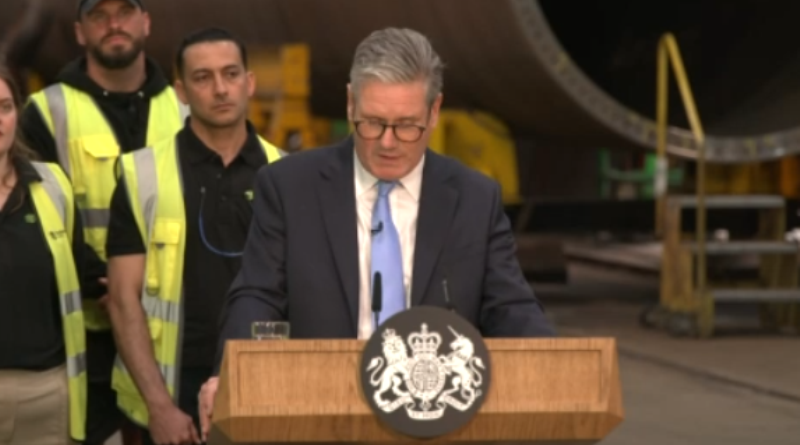£400m investment in key port shows how Scotland’s drive to net zero can create jobs – Kate Forbes
Scotland has vast natural capital in wind, water and land, a skilled marine engineering workforce, and the chance to become a leader in floating offshore wind
The world is changing profoundly, with the transition to a global net-zero emissions economy well underway. Scotland has played an essential part in the story so far, embracing renewables at an early stage and becoming one of the first nations in the world to declare a climate emergency.
However the climate crisis means that accelerating and intensifying action is essential – not just to ensure the decarbonisation of Scotland’s economy, but to support other nations in their net-zero journey.
Our ambitious target of reaching net zero by 2045 is critical beyond the climate imperative – most notably, the impact on our economy. Scotland has everything to gain by making the right investments now in the skills and infrastructure needed for the future. We can produce secure, cost-efficient energy. We can cut carbon emissions and achieve lasting economic benefits.
The Green Industrial Strategy which I published this week will ensure we capitalise on Scotland’s advantages – its natural environment, skilled workforce, world-class academic institutions – and turn opportunities into jobs, investment and green economic growth.
The race to net zero means a race to implementation, not just intention, which is why the strategy identifies five priority areas where we believe Scotland’s greatest strengths lie and our work will be most effective: offshore and onshore wind; the hydrogen sector; carbon capture, utilisation and storage; green professional and financial services; and clean energy intensive industries, including supporting the electrification of industries which use a lot of power, such as chemical and steel manufacturing and paper mills.

There’s money to be made in harnessing the power of Scotland’s sometimes wild weather (Picture: Jeff J Mitchell) | Getty Images
Scotland has diverse natural capital – wind, water and land with huge economic value. We have potential first mover advantage in floating offshore wind and an established onshore wind industry which has seen us move early in remanufacturing and decommissioning.
Expertise in oil and gas also provides us with a world-class subsea engineering workforce and existing strong offshore supply chains, as well as infrastructure that can be repurposed to sequester carbon in the North Sea and support hydrogen pipelines. Added to that are a highly skilled energy workforce – including oil and gas workers in the North East – geographical proximity to European markets, and a strong culture of research and development.
Giving investors confidence
Scotland already has a headstart in making the most of the move to net zero for the benefit of its people and communities. Now we must capitalise on the economic impact of that transition.
To do that, we will partner with public institutions, business, industry, unions, investors and academia. By prioritising resources and investment to create an environment for growth, and by coordinating policy.
Concrete actions include improving planning and consenting processes to enable Scotland’s net-zero development pipeline. We will host a Global Offshore Wind Investment Forum in spring 2025 – to build investor confidence, attract more capital investment to Scotland and create jobs.
We also plan to commercialise university research by funding support for new green businesses to develop prototypes and test new manufacturing processes. And we will work with local authorities and the private sector to develop hydrogen hubs across Scotland.
The Green Industrial Strategy sets out how we will use the policy levers available to us to support growth and investment. It is a clear statement of direction, focus, and intent. It outlines how we will remove barriers, create incentives and provide support wherever we can. By doing so, it provides clarity for businesses looking to invest in Scotland.
We have already shown how we can work together to leverage private investment into essential infrastructure. Ardersier Port, for example, is set to become the site of the largest dedicated offshore wind facility in Scotland, with the potential to provide up to 3,000 jobs and re-establish the port as a major local employer.
The Scottish National Investment Bank provided a £50 million credit facility alongside £50 million from the UK Infrastructure Bank to accelerate the development, which has received a £300 million capital commitment from the Quantum Capital Group.
Opening up new markets
I am confident the Green Industrial Strategy’s sustained and tangible focus on priority areas will enable us to attract more investments like this and create more jobs, across all sectors and across the country.
Yesterday I visited Flowcopter in Loanhead – an aviation company which is developing a heavy-lift drone which can be used to carry equipment to offshore wind sites, reducing the health and safety risks and also the downtime waiting for mobilisation of helicopters or marine vessels. This is a perfect example of a business which has not only recognised the opportunities of renewable energy but is innovating by looking at using sustainable fuels.
Flowcopter is one of countless businesses in Scotland seeing new markets opening up due to the energy transition. They need to know that there is support and investment out there to help them make the most of this next phase.
That is why the Green Industrial Strategy is focused on creating the environment for growth and giving business the tools to respond to new market opportunities as they arise. This has been guided by extensive engagement with businesses and investors.
Enduring economic growth
Of course, we have the capacity to unlock other opportunities beyond the five priority areas as work progresses. And we will adapt and evolve this strategy in response.
Our objective is to innovate, create jobs, solve problems with new products and sell Scotland’s expertise to the world. But most importantly, to realise the enduring economic growth opportunities from the global transition to a clean, green economy and ensure this benefits all of Scotland’s communities.
We have a genuine chance, not only to change Scotland for the better but to play a significant part in changing the world for the better.
Kate Forbes is Deputy First Minister and Economy Secretary
Source: scotsman.com




